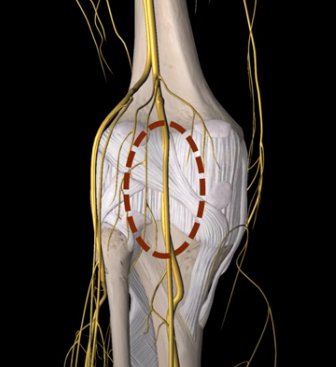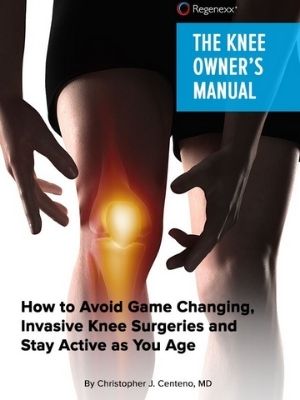Pain Behind Knee
Get Help With Pain Behind KneePain in the Back of the Knee: 5 Possibilities
First off, this is where the hamstrings and calf muscles attach. They have tendons here that are inserted into the bone. So if there’s a problem in the muscle or the tendon, you’re going to feel it right here. This is also where deep muscles like the popliteus and plantaris live. So, if these have issues, you’re going to feel it in the back of the knee.
In addition, the tibial nerve is back here. So if there’s an issue with a nerve in your back or a nerve locally, behind the knee, you’re going to feel it here.
And the meniscus or the joint spacer lives back here. So a tear in the meniscus could cause pain.
It’s also possible to get what’s known as a “baker’s cyst,” which is really just a blow out the Synovial lining, or the back wall of the knee joint.
So, how can you tell if you have one of these?
Either a muscle-tendon problem, a nerve issue, a tear in your meniscus, or a baker’s cyst?
If it’s a muscle-tendon issue…
Well, if it’s a muscle issue or a muscle-tendon issue, you generally have tightness in the muscle and you can feel that tightness. In addition, the tendons themselves may be tender.
If It’s a Nerve Issue…
If it’s a nerve issue, you might have numbness, tingling, burning, or electrical sensations in the leg or foot.
Also, realize that the nerves in your back can cause the same problem. And that might be if you have back pain or, maybe if you don’t have a lot of back pain right now, you’ve had back problems in the past.
If It’s a Meniscus Tear…
A meniscus tear can also cause it, which is going to be local pain in the back of the joint. Now just be very, very careful, because most middle-aged or older patients have meniscus tears. They’re like wrinkles.
So just because some doctor took an MRI, and it shows a meniscus tear does not mean that that’s the cause of your pain. In addition, meniscus surgery has been shown in multiple high-level studies to be no better than sham or placebo. So don’t get your meniscus operated on. Could also be a baker says you’ll feel fluid at the back of your knee and this will get bigger with more activity and smaller with less activity. So to find out more about how to fix these problems without surgery, and by using advanced regenerative medicine, Regenexx.com.
Conditions We Treat Associated with Pain Behind the Knee
Baker’s Cyst
A Baker’s cyst can cause knee pain. A Baker cyst is swelling caused by fluid from the knee joint protruding to the back of the knee. They are NOT a true cyst since it has communication with the synovial sac. They typically arise from degenerative changes or injury to the articular cartilage (arthritis) or meniscus. At the Centeno-Schultz Clinic, we believe that baker’s Cysts are simply a barometer of the health of the knee joint. In a healthy knee, there are absent whereas with injury and degenerative changes they are common. They arise between the tendons of the medial head…
Read More About Baker’s CystHamstrings Tendinopathy
Hamstring tendinopathy, a condition that causes pain and tenderness in the hamstring tendons, represents a common but often misunderstood musculoskeletal issue. It typically occurs in athletes and individuals engaged in high-intensity activities but isn’t limited to them. This condition, including its more specific form, high hamstring tendinopathy, can significantly impact daily and athletic performance, making understanding its nuances critical.
Read More About Hamstrings TendinopathyKnee Arthritis
In the human body, a joint is simply where 2 ends of bone come together. At the ends of these bones, there is a thick substance called “Hyaline Cartilage” that lines the ends. Hyaline cartilage is extremely slippery which allows the two ends of the bone to slide on top of each other. Then there is a capsule that connects the two ends filled with “synovial fluid” that acts as a further lubricant to make it more slippery! Arthritis in the knee is defined by loss of the hyaline cartilage plus other changes that happen to the bone such as additional bone being laid down (bone spurs/osteophytes). The cartilage layer is worn down to the point of exposing the underlying bone they cover…
Read More About Knee ArthritisKnee Instability
Knee instability is a condition that results when the knee joint is unstable and does not move or function normally. This can cause the knee to feel like it is going to give out or buckle. Knee instability can be caused by a variety of factors, including trauma or injury to the knee, ligament injury, arthritis or other degenerative diseases of the knee, weakness or instability of the muscles around the knee, muscle atrophy, injury to another joint in the body creates an imbalance. Knee stability, and stability in general, is very important. Lack of knee stability can lead to more problems over time, such as pain and arthritis…
Read More About Knee InstabilityMeniscus Tears
The meniscus is a c-shaped piece of cartilage in the knee that functions as an important shock absorber. It is sandwiched between the thigh and shin bone. There are two menisci per knee. One on the inside portion of the knee (medial) one on the outside aspect (lateral). The knee meniscus is susceptible to injury. The most common injury is a tear in the meniscus. Not all meniscus tears however cause pain. When symptomatic a meniscus tear can cause pain, swelling, and restriction in range of motion. Tears in the knee meniscus can arise from trauma or degeneration. There are many different types of meniscus tears based upon locations….
Read More About Meniscus TearsPCL Sprain
The Posterior Cruciate Ligament is one of the paired ligaments in the middle of the knee. It is made up of 2 separate bundles: The two bundles of the PCL, and the ALB (anterior lateral bundle), and the PMB (posterior medial bundle), function synergistically to provide stability. The PCL functions as one of the main stabilizers of the knee joint and serves primarily to resist excessive posterior translation of the tibia relative to the femur. The PCL also acts as a secondary stabilizer of the knee preventing excessive rotation specifically between 90° and 120° of knee flexion. A PCL sprain happens when force is applied beyond…
Read More About PCL SprainPCL Tear
The Posterior Cruciate Ligament (PCL) is a paired ligament in the middle of the knee. It is made up of two separate bundles: ALB (anterior lateral bundle) and PMB (posterior medial bundle). These bundles work synergistically to provide stability. The PCL plays an important stabilizing role in the knee joint by resisting excessive posterior translation of the tibia relative to the femur. Between 90 and 120 degrees of knee flexion, it serves as secondary support for preventing excessive rotation. PCL tears happen when force is applied beyond what the PCL tensile strength is capable of resisting. The tensile strength of the PCL is well documented…
Read More About PCL TearPes Anserine Bursitis
Knee pain located at the lower inside of the knee can be caused by Pes Anserine Bursitis, which is irritation of the tendons that run on the inside aspect of the knee. Commonly mistaken for arthritic pain, meniscal pain, and sometimes nerve pain from the low back! Don’t be misdiagnosed, and let’s dive in below to get a better understanding of Pes Anserine Bursitis. The Pes Anserine Bursa is a bursa that surrounds 3 tendons of the leg. A bursa is a thin, slippery, sac-like film that contains a small amount of fluid. A bursa is found between bones and soft tissues in and around joints…
Read More About Pes Anserine Bursitis


